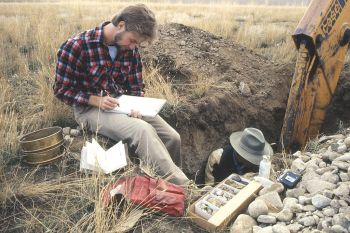Site Reconnaissance

|
| Soil Survey |
"A preliminary investigation consists of a field study and a review of available literature and maps relating to regional geology and physiography. The general physical feasibility of the site is assessed and specific questions to be answered during the design process posed. Field studies should include a thorough inspection of outcrops, cut banks, and other surface exposures and an examination of erosion conditions, landslides, seeps, springs, and other conditions on and adjacent to the project site."[1]
"The geologist and the designer should discuss geologic conditions that may influence the design, construction, cost, and functioning of the proposed structure. If these conditions appear adverse, a more intensive investigation may be required to assess site feasibility."[1]
"In areas where the soils and geologic conditions are well known, a detailed investigation may not be necessary for small, low-hazard structures. For such structures, the preliminary investigation needs to be sufficiently detailed to provide relevant information on site materials, conditions, and engineering characteristics for planning, design, and cost estimates."[1]
See also: Geotechnical and Geology > Geologic History
Best Practices Resources
![]() National Engineering Handbook: Chapter 2 - Engineering Geologic Investigations, NRCS, 2012
National Engineering Handbook: Chapter 2 - Engineering Geologic Investigations, NRCS, 2012
![]() National Engineering Handbook: Chapter 2 - Engineering Geologic Investigations, NRCS, 2012
National Engineering Handbook: Chapter 2 - Engineering Geologic Investigations, NRCS, 2012
![]() Design of Small Dams, USBR, 1987
Design of Small Dams, USBR, 1987
Trainings
![]() On-Demand Webinar: Field Investigations for New and Existing Dams
On-Demand Webinar: Field Investigations for New and Existing Dams
Citations:
Revision ID: 6677
Revision Date: 03/16/2023
